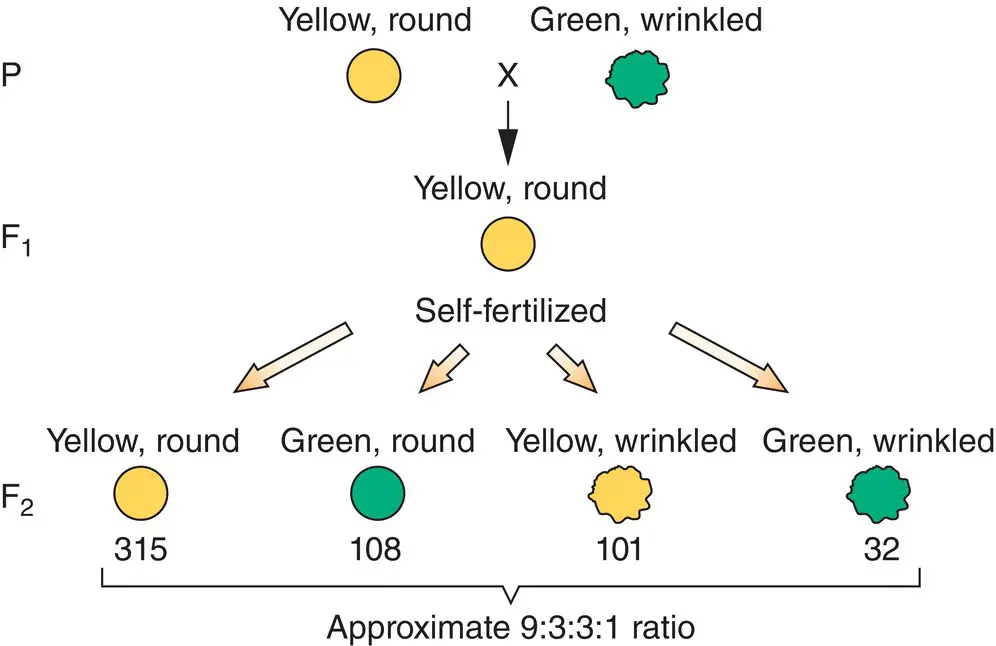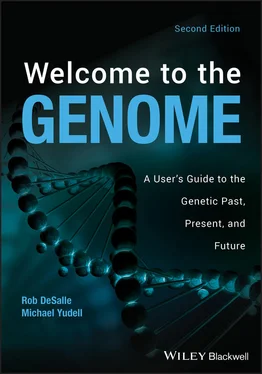1 ...7 8 9 11 12 13 ...21 Without the assistance of a calculator or computer, Mendel counted thousands and thousands of plants. Even more remarkable, he constructed lineages that had all possible combinations of two of the seven traits together. For example, he crossed a line of pea plants with round yellow seeds with a line whose seeds were wrinkled and green. This cross gave rise to first‐generation plants with seeds that were all yellow and smooth. But when he crossed these first‐generation plants to each other (a self‐cross), an amazingly regular ratio in the offspring arose—the seeds of nine were yellow and round, three yellow and wrinkled, three green and round, and one green and wrinkled. Mendel reasoned that mating these first‐generation plants was like taking the two possible types of each trait (e.g., seed texture and seed color) and throwing them into a hat. Nature then randomly chose from the hat how to combine the genes. Although the choice is random, the outcome is a remarkably regular ratio of 9:3:3:1. (23).

Figure 1.4Mendel’s first law of segregation says that alleles will segregate randomly between generations. Mendel’s second law, the law of independent assortment, represented in the figure above, says that pairs of alleles will segregate independently between generations. (P = parents, F 1= first generation, F 2= second generation).
Credit: Wiley
These observations are now known as Mendel’s second law, the law of independent assortment—if two traits (genes) are being controlled with different controllers (alleles), offspring will be produced by random combinations of the controllers (alleles). (24) In other words, a trait is independently and randomly distributed among offspring.
Mendel was either very lucky or very perceptive: it turns out that seven is the number of chromosomes of Pisum . For all seven of the traits he examined to show true independent assortment with respect to one another, none of them can be linked—that is, none of them can be on the same chromosome (or in the case of one of the traits he examined, they have to be very far apart on the same chromosome). (25) Mendel must have watched his peas very closely. Perhaps he recognized the pattern of segregation as he was weeding his garden and thus performed his experiment with an expectation based on his knowledge as a pea biologist. Or, perhaps, he selectively looked at his data and forgot to record crosses that deviated from the ratios 3:1 and 9:3:3:1. Either way, his conclusions have not been overturned.
Mendel died on January 6, 1884, nearly 20 years after his momentous study with Pisum had been published. (26) Even though its significance remained unheralded, Mendel’s work as a scientist and as a servant of God was recognized by his peers. If Mendel had been luckier in choosing the journal in which to publish his findings, he might have been famous in his own time, but he published in an obscure scientific journal and died in genetic obscurity (his monastic calling guaranteed that). (27) Although his contemporaries did cite his work with Pisum , they probably did not comprehend its deeper meanings for what would become a cornerstone of hereditary theory. A tribute to Mendel by a fellow scientist in Brünn lauded him as one of the great scientists of his day who worked “almost exclusively on detailed natural scientific studies, in which he displayed a totally independent, unique way of thinking.” (28) Unfortunately, it would take the world another 16 years after his death to uncover the greatness of Mendel’s investigations.
The lack of attention to Mendel’s work may also be explained by the near obsession with evolution in the mid‐nineteenth century after the publication of Darwin’s The Origin of Species . Darwin’s work was published just 6 years before Mendel’s and captured public attention well into the twentieth century, leaving Mendel’s theory to languish quietly. (29)
The “rediscovery” of Mendel in 1900 was driven in part by what biologist Ernst Mayr calls “an accelerating interest in the problem of inheritance.” (30) Incredibly, in the spring of that year three botanists—Hugo de Vries, Carl Correns, and Erich Tschermak—all claimed to have discovered laws of inheritance. They soon learned, unfortunately, that Mendel’s work was nearly identical and had preceded them by 35 years. (31) In the coming decades, Mendel’s laws of segregation and independent assortment would be tested on a wide variety of species.
With only four pairs of chromosomes, the ability to produce offspring at a pace that would make even the most reproductively prolific blush, and the fact that it can live in the austere environment of a laboratory storage bottle, the six‐legged Drosophila melanogaster , or fruit fly, has been the workhorse of genetics for more than 100 years.
Beginning early in the twentieth century, Thomas Hunt Morgan and his students at Columbia University capitalized on Drosophila ’s valuable qualities and began breeding fruit flies by the hundreds of thousands, hoping to find variations or mutations in fruit fly traits that would help explain Mendel’s laws in real‐life situations. Morgan’s laboratory, dominated by work with Drosophila, became known as the fly room, a moniker that can only partly suggest the overwhelming number of flies present in a space that measured just 16 × 23 feet. (32) Today the fly room is frequented by one of the present authors—part of it still exists at Columbia University (if you are looking for it, it is now the men’s bathroom on the sixth floor of Schermerhorn Hall).
During the 1910s, thanks in large part to the work conducted in the fly room, genetics shifted from simply testing Mendel’s laws of inheritance to studying the physical arrangement of genes on chromosomes. Interestingly enough, the terminology of what we now call genetics was not even in place. Morgan and his genetically minded colleagues were pioneers in a field that was quickly becoming known as genetics, a word coined by botanist William Bateson in 1906. The word gene was itself first defined by the German biologist Wilhelm Johannsen in 1909. (33) The new terminology and the field of work and entity it describes are still used today.
Morgan, formerly a critic of Mendelian theory, came to embrace the new genetics because of some surprising results in his own research. In 1910 he discovered something startling among one of his breeds of Drosophila— a lone white‐eyed male fly. When it was bred with a normal (red‐eyed) female, all of the offspring had red eyes. When flies from the first generation were crossed, the white‐eyed character reappeared, but surprisingly only in half of the males. Finally, when white‐eyed males were bred with first‐generation females, 50% of both males and females had white eyes. Morgan called this change a mutation and spent much of his career studying such mutations in order to decipher the nature of genes and the structure of chromosomes. (34)
Ultimately Morgan saw that Mendelian laws of segregation and independent assortment easily explained these patterns. Morgan’s biographer Garland Allen suggests that these results were the main factor in Morgan’s acceptance of Mendelism. (35)
The white‐eyed Drosophila was a mutant variation of the normal red‐eyed type. These types of mutations in physical characteristics became the means by which Morgan and his students at Columbia began to describe the physical entities of genes and chromosomes. People tend to think of genetic mutations as frightening, a change caused by exposure to something dangerous or a freakish event or accident. A few things drive this fear. Most obvious is a misunderstanding of what a genetic mutation is and what it means for an organism. The other is that people have often described mutations as the result of exposure to atomic radiation either in real life (Nagasaki, Hiroshima, Chernobyl, or Fukushima) or in science fiction (Godzilla). It is true that the ill‐effects on people exposed to high levels of radiation at atomic bomb sites are real and that cancer rates among survivors of Hiroshima and Nagasaki were substantially higher than normal because of mutations caused by the atomic bomb’s radiation. (36) But mutations are generally not of this type, nor do they create the Godzilla‐like creatures that have appeared in science fiction for the past half‐century. Mutation comes from the Latin word meaning change, so a mutation is simply a change in an organism’s DNA sequence—a change that may have no measurable effect on the organism or may confer either a beneficial or adverse effect. Random errors that occur during cell division are the most common cause of mutation. Most mutations are unpredictable, as are their effects.
Читать дальше













